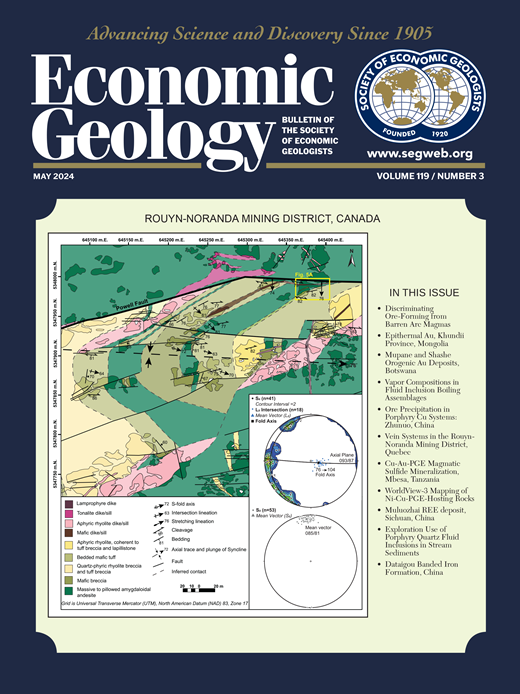俯冲到碰撞后构造环境中斑岩-浅成热液转换的区域尺度VMS:土耳其东Pontides带Artvin Au-Cu地区和Hod金走廊
IF 5.5
1区 地球科学
Q1 GEOCHEMISTRY & GEOPHYSICS
引用次数: 3
摘要
斑岩型、浅成热液型和火山成因块状硫化物(VMS)矿床可在辐合边缘环境的同一矿区内同时形成。它们的空间组合和叠加反映了演化的构造背景。Artvin Au-Cu地区是土耳其东北部东庞德带VMS双峰长英质、斑岩和浅成热液矿床的主要聚集区之一。虽然arvin地区VMS矿化的成矿过程、时间和构造背景已经明确,但斑岩和浅成热液矿化的成矿过程、时间和构造背景仍然不太明确。本区的野外研究主要集中在Artvin地区的Hod金走廊,该走廊由近期发现的Au- cu矿(~ 205t Au;~0.33 Mt Cu;(如Hod Maden、ardala - salinbaku和Taç-Çorak),包括富金斑岩、高、中硫化浅成热液、碳酸盐岩替代和vms -浅成热液混合成矿样式。新的U-Pb、40Ar/39Ar和Re-Os年代学结果表明,Artvin地区岩浆活动形成于石炭纪(358-325 Ma)、侏罗纪(182-174 Ma)、晚白垩世(92-78 Ma)、始新世(51-40 Ma)和渐新世(30 Ma)。沿Hod金走廊的斑岩和浅成热液成矿作用在早(~113 Ma)达到高峰;Berta远景)和晚白垩世(~86.5-82 Ma;例如Taç和Çorak矿床)和始新世(~50 Ma;如Ardala矿床),而VMS双峰长英质矿化仅形成于晚白垩世(~91 ~ 85 Ma)。因此,我们认为Hod金走廊是一个长期存在的深部地壳尺度构造特征,连续的岩浆和成矿事件发生在此。此外,斑岩铜钼矿化的时间可以明显(>20 Ma)晚于arvin地区侵入寄主岩的结晶年龄,如Berta和Balcılı营地,这强调了直接定年对正确归属构造背景的重要性。晚白垩世矿物赋存物的分布表明,北新特提斯洋板块回退开始时,北新特提斯洋板块从弧后环境过渡到弧后环境(~86.5 ~ 82 Ma),并伴随金含量向东升高,横跨Artvin地区。本文章由计算机程序翻译,如有差异,请以英文原文为准。
District-Scale VMS to Porphyry-Epithermal Transitions in Subduction to Postcollisional Tectonic Environments: The Artvin Au-Cu District and the Hod Gold Corridor, Eastern Pontides Belt, Turkey
Porphyry, epithermal, and volcanogenic massive sulfide (VMS) deposits can form together in the same mineral district in convergent margin environments. Their spatial association and superposition indicate evolving tectonic settings. The Artvin Au-Cu district is one of the major clusters of VMS bimodal-felsic, porphyry, and epithermal deposits in the Eastern Pontides belt in northeast Turkey. Whereas ore-forming processes, timing, and tectonic setting of VMS mineralization are well defined in Artvin, those for porphyry and epithermal mineralization remain less constrained. Our district-scale field study focused on the Hod gold corridor in the Artvin district, which is defined by the NE-trending alignment of the recent Au-Cu mineral discoveries (~205 t Au; ~0.33 Mt Cu; e.g., Hod Maden, Ardala-Salinbaş, and Taç-Çorak) that include Au-rich porphyry, highand intermediate-sulfidation epithermal, carbonate-replacement, and hybrid VMS-epithermal mineralization styles. Our new U-Pb, 40Ar/39Ar, and Re-Os geochronological results interpreted with previously compiled data show that magmatism in the Artvin district formed in the Carboniferous (358–325 Ma), Jurassic (182–174 Ma), Late Cretaceous (92–78 Ma), Eocene (51–40 Ma), and Oligocene (30 Ma). Porphyry and epithermal mineralization along the Hod gold corridor peaked in the Early (~113 Ma; Berta prospect) and Late Cretaceous (~86.5-82 Ma; e.g., Taç and Çorak deposits) and Eocene (~50 Ma; e.g., Ardala deposit), whereas VMS bimodal-felsic mineralization only formed in the Late Cretaceous (~91–85 Ma). Therefore, we interpret that the Hod gold corridor was a long-lived, deep crustal-scale structural feature along which the successive magmatic and mineralization events were emplaced. In addition, the timing of porphyry Cu-Mo mineralization can significantly (>20 Ma) postdate the crystallization age of the intrusive host rocks in the Artvin district, such as at Berta and Balcılı camp, which emphasizes the importance of dating mineralization directly to correctly attribute the tectonic setting. The distribution of Late Cretaceous mineral occurrences suggests a possible eastward temporal evolution from VMS (~91–85 Ma) to epithermal-porphyry systems (~86.5–82 Ma), transitioning from back-arc to arc settings at the onset of the Northern Neotethyan oceanic slab rollback and accompanied by increasingly elevated gold content eastwards across the Artvin district.
求助全文
通过发布文献求助,成功后即可免费获取论文全文。
去求助
来源期刊

Economic Geology
地学-地球化学与地球物理
CiteScore
10.00
自引率
6.90%
发文量
120
审稿时长
6 months
期刊介绍:
The journal, now published semi-quarterly, was first published in 1905 by the Economic Geology Publishing Company (PUBCO), a not-for-profit company established for the purpose of publishing a periodical devoted to economic geology. On the founding of SEG in 1920, a cooperative arrangement between PUBCO and SEG made the journal the official organ of the Society, and PUBCO agreed to carry the Society''s name on the front cover under the heading "Bulletin of the Society of Economic Geologists". PUBCO and SEG continued to operate as cooperating but separate entities until 2001, when the Board of Directors of PUBCO and the Council of SEG, by unanimous consent, approved a formal agreement of merger. The former activities of the PUBCO Board of Directors are now carried out by a Publications Board, a new self-governing unit within SEG.
 求助内容:
求助内容: 应助结果提醒方式:
应助结果提醒方式:


